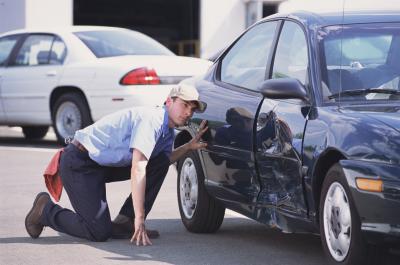
Dents are an unfortunate daily occurrence for vehicle owners, whether they own RVs, cars or trucks. Any moving vehicle that has metal panels can suffer impact damage anytime, anywhere. Body shops can charge up to hundreds of dollars to repair dents, depending upon their size, location and the tools required to repair them. Fortunately, vehicle owners can use some basic physics to repair many of their own dents, without ever leaving their garage or driveway. Using heat and Co2 in just the right application can remove many types of panel dents, without using any tools or special machines.
Place the vehicle inside a sheltered car port or inside a garage, away from direct sunlight. Make sure you have no strong wind drafts and that the outside ambient temperature is moderate, or at least between 65 and 85 degrees Fahrenheit.
Examine the surface area and the depth of the dent you wish to repair. Dents that have large surface areas but are shallow in depth are good candidates for the hot-cold method of repair. If the dent has deep creases where the metal has been cut, gouged or stretched at or near the body panel or edges, the creases might not disappear with the treatment.
Apply strips of masking tape around the perimeter of the dent to give you some scale on its size. Be mindful of dents that are near the edges of door panels, and remember that excessive heat can loosen the glue to weather stripping or melt the weather stripping material.
Plug in a high-watt hairdryer and set it on maximum. Heat the dent area for about three to five minutes, starting in the middle of the dent and working toward the ends in a circular pattern. Do not hold the hairdryer nozzle directly against the metal surface, or you'll get the metal too hot. If the paint begins to yellow or brown, it means you have overheated the clear coat or paint. Don a pair of insulated gloves. Shut off the hairdryer and immediately spray the dent area with Co2, either from a spray can or a Co2-type fire extinguisher.
Watch the dent and listen for the metal to creak. The sudden expansion and contraction will force the metal back into its original shape, and it should snap back into its original profile. Repeat the procedure if it does not work the first time.